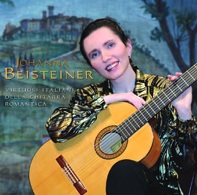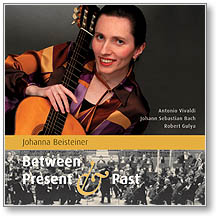 |
Beisteiner, Johanna
Austria
|
|
|
|
|
|
|
| |
|
Live in Budapest
|
classical |
|
 The Viennese concert guitarist Johanna Beisteiner gives on this DVD a detailed overview of her large repertory and versatile artistic projects. Besides famous works by Vivaldi, Schubert, Bach and Tárrega she also plays contemporary music. In the centre of attention stands the cooperation with the Hungarian composer Robert Gulya, whose Concerto for guitar and orchestra is infl uenced by the events of 09/11 and expresses the confl icts of culturally diverse peoples.
The Viennese concert guitarist Johanna Beisteiner gives on this DVD a detailed overview of her large repertory and versatile artistic projects. Besides famous works by Vivaldi, Schubert, Bach and Tárrega she also plays contemporary music. In the centre of attention stands the cooperation with the Hungarian composer Robert Gulya, whose Concerto for guitar and orchestra is infl uenced by the events of 09/11 and expresses the confl icts of culturally diverse peoples.
For the shooting of the video clip The Milonguero and the Muse Johanna Beisteiner has been working with the Argentine dancer and choreographer Rafael Ramirez. A Milonguero is a man, who tries to seduce women by dancing Tango. The clip is about a frustrated Milonguero searching for the woman of his dreams. When he catches sight of a guitarist, he thinks to have found his muse. But when dancing together, they fi nd out, that they do not fi t to each other. This story is symbolic of the often sad reality in Tango: hope, expectation and disappointment.
Eduard Shafransky’s piece Refl ections on a painting by Caravaggio is based on the famous Lute player (1596). Until the 18th century the lute was a very popular instrument, but later the guitar gained increasing importance. That’s why the video is called Caravaggio today.
Technical parameters:
DTS 5.1
Dolby Digital 5.1
Dolby Stereo
Audio: Hungarian, German
Subtitles: English, German, Hungarian, French, Italian, Spanish, Russian
Playable on all DVD players
Aspect ratio: 16:9
|
|
Comments
(0 messages) |
|
GR 089 |
DVD |
2010 |
0.00
€ |
 |
|
|
|
|
|
|
|
|
|
|
| |
|
Virtuosi Italiani della chitarra romantica
|
classical |
|
 The 19th century had a vital impact on the evolution of the guitar as a solo musical instrument: both the structure of this instrument altered and the scope of the playing techniques widened. many important virtuosos came from Italy in those days, inter alia Mauro Giuliani, Niccolò Paganini, Ferdinando Carulli and Luigi Legnani.
The 19th century had a vital impact on the evolution of the guitar as a solo musical instrument: both the structure of this instrument altered and the scope of the playing techniques widened. many important virtuosos came from Italy in those days, inter alia Mauro Giuliani, Niccolò Paganini, Ferdinando Carulli and Luigi Legnani.
The 6 Rossiniane opp. 119-124 evidently verify the Rossini fever that prevailed the general musical life around 1820. Presumably, Giuliani composed these pieces in the term of his residence in Rome between 1820 and 1823. Owing to the fact that Gioacchino Rossini also resided in the city in the corresponding period we may assume that the two composers met each other, yet there has been no unambiguous proof for it. The Rossiniana No. 1 echoes the themes of Rossini’s two operas, namely The Italian Girl in Algiers and Armida.
Paganini has been known as an excellent violin player, only few have been aware of his outstanding guitar playing skills, by which he composed a series of artworks for this musical instrument. His Grand sonata in A major was originally composed for the guitar with violin accompaniment. Since the violin had a very negligible part, it was obvious to perform the sonata in a transcription for guitar solo.
Carulli’s Six Andantes contrast the rest of the works recorded. In contravention to Giuliani’s Rossiniana and Paganini’s Grand sonata in A major these pieces scarcely contain virtuosic parts, such as rapid scale passages, or complex changes of positions, but rather require much efforts from the interpreter in concern to performing the tone colours as well as the skill to apply the legato technique.
Legnani’s 36 Caprices hold an extraordinary position within the guitar repertoire, since they consist of all major and minor keys. The composer also uses keys, which normally are unusual for the guitar because of the instrument’s pitch.
The photos used for the design of this compact disc were taken in Montecastello di Vibio (Italy) at the Teatro della Concordia, which has been listed in the book of Gunniess World Records as the smallest historic theater in the whole world. The Teatro della Concordia was built in 1808 by Italian aristocrat families during the epoch of the Napoleonic invasion. Concordia – stands for union, by which the architect wished to remind of the idea beyond the French Revolution: the spirit of freedom, equality and brotherhood. The interior of the theater has been decorated with Luigi Agretti’s frescos dating back to 1892.
| 1. | Mauro Giuliani - Rossiniana Nr. 1 op. 119 | | 2. | Ferdinando Carulli - I. Andante affettuoso con poco moto (Sei Andanti op. 320) | | 3. | Ferdinando Carulli - II. Andante con moto (Sei Andanti op. 320) | | 4. | Ferdinando Carulli - III. Andante molto sostenuto (Sei Andanti op. 320) | | 5. | Ferdinando Carulli - IV. Andante giusto (Sei Andanti op. 320) | | 6. | Ferdinando Carulli - V. Andante - Leggiero e grazioso (Sei Andanti op. 320) | | 7. | Ferdinando Carulli - VI. Andante risoluto (Sei Andanti op. 320) | | 8. | Niccolò Paganini - I. Allegro risoluto (Grand Sonata in A major) | | 9. | Niccolò Paganini - II. Romanza (Grand Sonata in A major) | | 10. | Niccolò Paganini - III. Andantino variato (Grand Sonata in A major) | | 11. | Luigi Legnani - Nr. 18 F minor (from 36 Caprices op. 20) | | 12. | Luigi Legnani - Nr. 26 C# minor (from 36 Caprices op. 20) |
|
|
Comments
(0 messages) |
|
GR 070 |
CD |
2007 |
0.00
€ |
 |
|
|
|
|
|
|
|
|
|
|
| |
|
Salon
|
classical |
|
 The talented Austrian guitar player has published already her third record in Hungary. On the artistic CD, the excellent Hungarian pianist, Róbert Gulya also plays as a guest star.
The talented Austrian guitar player has published already her third record in Hungary. On the artistic CD, the excellent Hungarian pianist, Róbert Gulya also plays as a guest star.
| 1. | Fernando Sor - Variations on a Theme by Mozart op. 9 | | 2. | Carl Maria von Weber - Divertimento op. 38 for guitar and piano - Andante con moto | | 3. | Carl Maria von Weber - Divertimento op. 38 for guitar and piano - Walzer | | 4. | Carl Maria von Weber - Divertimento op. 38 for guitar and piano - Andante con variazioni - | | 5. | Carl Maria von Weber - Divertimento op. 38 for guitar and piano - Polacca | | 6. | Anton Diabelli - Sonata A major - I. Allegro moderato | | 7. | Anton Diabelli - Sonata A major - II. Andante sostenuto | | 8. | Anton Diabelli - Sonata A major - III. Minuetto (quasi Scherzo) | | 9. | Anton Diabelli - Sonata A major - IV. Rondo (allegretto) | | 10. | Franz Schubert - Ständchen from Schwanengesang D 957 | | 11. | Miguel Llobet - El testamento de Amalia | | 12. | Miguel Llobet - El noy de la Mare |
|
|
Comments
(0 messages) |
|
GR 036 |
CD |
2002 |
0.00
€ |
 |
|
|
|
|
|
|
|
|
|
|
| |
|
Between Present and Past
|
classical |
|
 Between Present and Past, the new album by the Austrian guitarist Johanna Beisteiner, is a special medley of works by distinguished composers of the past and contemporary music by the highly talented Hungarian composer Robert Gulya (*1973), who dedicated two new works to Johanna Beisteiner: a Guitar Concerto and a Capriccio for guitar and piano.
Between Present and Past, the new album by the Austrian guitarist Johanna Beisteiner, is a special medley of works by distinguished composers of the past and contemporary music by the highly talented Hungarian composer Robert Gulya (*1973), who dedicated two new works to Johanna Beisteiner: a Guitar Concerto and a Capriccio for guitar and piano.
"First I wanted to compose a cheerful concerto for Johanna, but when I started to work on the first theme in late summer 2001 during a stay in Los Angeles the terrible event of September 11 influenced my thoughts. For this reason all movements became rather melancholic and sensitive. I tried to realize most of my musical ideas by using all technical possibilities of the guitar. That makes this concerto difficult and challenging even for highly skilled players.
With the Capriccio I wanted to prove that a contemporary guitar piece can be demanding and entertaining as well. Although the guitar is only rarely combined with the piano, these two instruments harmonize very well and give fresh and colourful sound to the composition.
Both pieces were written in order to show a broader public that the classical guitar has a great potential to become a real solo instrument in our concert life. After many years of collaboration I am convinced that both musically and technically Johanna is the perfect artist to reach this aim."
Robert Gulya
In 1704 the only 19-year-old Johann Sebastian Bach composed the Capriccio on the departure of the most beloved brother BWV 992. This piece is supposed to have been written on the departure of Bach' s brother Johann Jakob (1682-1722), who joined as an oboist the guard of the Swedish King Charles XII in 1704 for taking part at the Great Nordic War. Originally written for keyboard, the Capriccio was recorded on this CD in a new arrangement by Robert Gulya for guitar and strings. This cast intensifies the worried atmosphere and retains the intimate character of the original version as well. The piece consists of six movements with following subtitles: 1) Is a coaxing by his friends to dissuade him from his jouney. 2) Is a picture of various calamities that might overtake him in foreign parts. 3) Is a general lamentation of his friends. 4) Now come the friends, since they see that it cannot be otherwise, and say goodbye to him. 5) Air of the postilion. 6) Fugue in imitation of the postilion' s horn.
Antonio Vivaldi composed his Concerto in D major for lute, strings and cembalo. The lute was one of the most popular instruments in the baroque age, but later it was replaced by the guitar. Therefore the guitar takes the place of the lute also in this recording.
This CD was recorded in collaboration with several great musicians from Budapest: the Hungarian Radio Symphony Orchestra, the promising young conductor Domonkos Héja and the pianist Wanda Mazalin.
| 1. | Gulya Róbert - Concerto for guitar & orchestra - I. Allegro | | 2. | Gulya Róbert - Concerto for guitar & orchestra - II. Lento | | 3. | Gulya Róbert - Concerto for guitar & orchestra - III. Allegro | | 4. | Antonio Vivaldi - Concerto D-major for guitar - I. Allegro | | 5. | Antonio Vivaldi - Concerto D-major for guitar - II. Lento | | 6. | Antonio Vivaldi - Concerto D-major for guitar - III. Allegro | | 7. | J.S. Bach - Capriccio sopra la lontananza - I. Arioso | | 8. | J.S. Bach - Capriccio sopra la lontananza - II. Ist eine Vorstellung unterschiedlicher Casuum | | 9. | J.S. Bach - Capriccio sopra la lontananza - III. Adagiosissimo | | 10. | J.S. Bach - Capriccio sopra la lontananza - IV. Allhier kommen die Freunde | | 11. | J.S. Bach - Capriccio sopra la lontananza - V. Allegro poco | | 12. | J.S. Bach - Capriccio sopra la lontananza - IV. Fuga all' imitatione della posta | | 13. | Gulya Róbert - Capriccio for guitar & piano |
|
|
Comments
(0 messages) |
|
GR 052 |
CD |
|
0.00
€ |
 |
|
|
|
|
|
|
|
|
